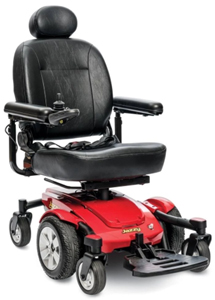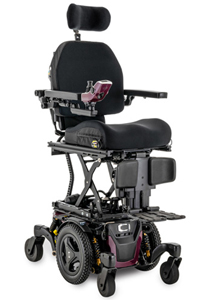Pride Learning Institute
Considerations for Power Wheelchairs
By: Alexandra “Alex” Chesney, OTR, ATP/SMS, Quantum Rehab Clinical Sales Manager – Midwest South Region
It’s hard knowing what your options are when coming to the conclusion that your client needs a power mobility device to be the most independent. Many times, while working in the hospital, I find myself at a crossroads of manual mobility vs. power mobility. I make sure to always reflect on what optimizes a client’s success now and in the future. With a background in neurological inpatient rehabilitation, this can become extra tricky because you can see recovery but that timeline is typically unknown.
First and foremost, when debating between a manual wheelchair or a power wheelchair, my number one question is “can the consumer do an independent pressure relief?” This means every 30 minutes for two minutes, per the PVA guidelines (Consortium for Spinal Cord Medicine, 2014). If someone cannot successfully perform proper pressure relief and does not have someone to assist him or her throughout the day, an alternate option must be prescribed. One possibility is a tilt-in-space manual mobility device, but this option may decrease independence of mobility and still requires assistance to perform the tilt feature. Skin protection should come first for those with limited mobility and changes in sensation, along with many additional risk factors.
Another consideration is to always focus on safe, timely, and independent mobility. Mobility should not contribute to overuse of upper extremities or risk physiological burnout that takes away from performance of functional tasks throughout the day. There are many ways to set up an efficient and effective manual wheelchair, but we must recognize the intended use and purpose of progressing to power mobility. We must objectively recommend power mobility when there is a great impact it can make in a client’s daily routine.
One thing to discuss before moving into comparing Group 2 and Group 3 power wheelchairs is understanding multiple power. In the CRT industry, the term multiple power refers to the power seating functions that change the position of the seating system: tilt, recline, adjustable seat height, not power legs. This can be confusing. For example, a power chair that can tilt and elevate legs is considered a single power chair. This is key to understanding and investigating the features your consumer requires and properly justifying the needs of the individual.
Qualifications for Power Mobility
- Client does not have sufficient upper extremity function to propel a manual wheelchair in the home to participate in mobility related activities of daily living (MRADLs) even if optimally configured.
- Explain why a manual wheelchair or scooter cannot provide safe, timely, independent mobility.
- They require the use of a joystick or alternative input device and have seating/positioning needs that cannot be met by a manual wheelchair or scooter.
- The consumer’s home has adequate access for maneuvering and they can safely use the power wheelchair.
Group 2 Power Wheelchairs
- Created for those using greater than two hours a day
- No added suspension
- Made for use on flat/hard surfaces
- Single power or multiple power
- Multiple power typically being limited to 2 power seating features
- Limited options
- Minimum requirements:
- Range up to 7 miles
- Top speed of 3 mph
- Obstacle climbing of 1.57 inches
- Obstacle climbing of 1.57 inches
- Basic/minimal programming
- Cannot use alternative drive controls (ex: head array)
- Diagnoses to consider include COPD, CHF, arthritis, peripheral neuropathy
 |
 |
| Jazzy Select 6 | J4 Power Chair |
Group 3 Power Wheelchairs
- Created for more active, continuous all-day users
- Those with neurological, myopathy, or congenital skeletal deformities
- Has suspension
- Helps maintain positioning in the chair
- Can decrease jarring and vibration which can assist in limiting pain/discomfort
- Helps with stability and longevity of the base
- Minimum requirements
- Range up to 12 miles
- Top speed of 4.5 mph
- Obstacle climbing of 2.362 inches
- Incline of 7.5 degrees
- Single and multiple power options:
- Tilt
- Recline
- Elevating/articulating leg rests
- Seat elevation
- Anterior tilt
- Custom programming capabilities and use of alternative drive controls
 |
 |
| Edge 3 Stretto Power Chair | Edge 3 Power Chair |


